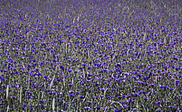Department of Horticulture
| Research Centre Aarslev Kirstinebjergvej 10 DK-5792 Aarslev tel:+45� 8999 1900 fax:+45� 8999 3490 [email protected] |
 |
Research director:� Ole Callesen
Profile
Activities at the Department of Horticulture
The research carried out at the Department of Horticulture aims at developing methods for improving the production potential, leading to an increased sustainable production of horticultural crops. We focus on product quality such as flavour, appearance, quality, health impact on human beings and post harvest quality. The research is based on plant and crop physiology ranging from the cultivation system and whole plant level to the biochemical and molecular level.
Sustainable production and climate
We do research into methods for improving plant production, leading to an increased sustainable production of fruit, vegetables and ornamental plants, both in the conventional as well as the organic production. This research includes management of water and nutrient supply and especially use of catch crops, green manure crops and compost for circulation of nitrogen and other nutrients in the cultivation system. Studies of root growth of green manure crops and catch crops and their nitrogen uptake are important themes, both for the development of organic growing systems and in relation to the Danish water environment plans. This work has resulted in development of crop simulation models and decision support systems.
Research into organic plant production includes fruit, berries and vegetables and involves many research disciplines. Therefore, we cooperate with scientists from other departments within the Faculty of Agricultural Sciences and research institutions both in Denmark and internationally. We focus on research into the impact of the production systems on plant resistance to pests and disease with a main emphasis on triggering natural mechanisms, including disease preventing growth control.
In relation to global climate changes we carry out research into a range of abiotic stress responses. We have a focus on drought stress and plant cold hardiness. For example plant cold hardiness under fluctuating temperatures, during an unstable winter, could be critical for the survival and normal growth of these plants. This is important to many woody plants grown outdoors, however, also in greenhouse production of ornamental plants where plant tolerance to low temperatures is of significance in relation to energy consumption.
Genetic resources and plant breeding
We examine the production value of old and new cultivars and commercial and wild cultivars. We evaluate product quality with special emphasis on resistance and tolerance to important plant diseases when used in conventional and organic production. A broad selection of cultivars is essential in horticultural production systems. These activities include clone selections of existing vegetable crops under Denmark's National programme for Plant Genetic Resources. These studies are carried out according to an action plan for preservation of plant genetic resources focusing on the wild relatives of food based plants and on the perspectives of old cultivars.
Production barriers in fruit growing are unstable flowering and retention of fruit. Flowering physiology is one of our focus areas including establishing new methods for overcoming problems with unstable fruit production e.g. sour cherries and pears. The aim of this research is to develop methods for accelerating the plant breeding process for woody plants.
We develop plant breeding methods for ornamental and fruit species with the purpose of producing plants with health promoting characteristics, increased pest and disease tolerance, and plants with improved ornamental and production value or quality. Several methods are being used and developed e.g. clone and seed source selection, hybrids, mutation treatment, chromosome doubling and transformation. An effort is made to improve the resource of plant material of ornamental plants through introduction of new material, plant breeding and selection. We carry out variety testing, under license for the Community Plant Variety Office (CPVO), of selected varieties of ornamental plants.
Plant quality and plant health
An essential research issue for all horticultural crops is improved product quality. Our research in this area includes research on production methods, fertilization, production systems, variety selection, harvesting methods, harvesting time, handling and storage. All these factors affect the keeping quality of the products, flavour, appearance and compounds significant for human health and well being. Focus is on the secondary metabolites of the plants which are important for flavour, but also on health-promoting effects of vegetables, fruit, berries and medicine plants. Research indicates that red coloured berries have significant health-promoting benefits and therefore this area has a high priority.
The research into medicinal plants is concentrated on the content of bioactive compounds, both in relation to important human lifestyle diseases, such as diabetes and diseases in the third world countries e.g. malaria, and veterinary medicine from the Artemisia annua plant. Evaluations are being carried out on how production methods may influence the content of bioactive compounds in a number of plant species.
Ornamental plants and energy consumption
Research into potted plants focuses on growth and post production performance. The influence of the production conditions is investigated, including the plants ability to tolerate stress. Focus is on elucidating physiological responses, especially with regard to photosynthesis, and obtaining a mechanistic understanding of plant growth and quality. This is based on the use of dynamic growth control. A targeted effort is being made to increase the assortment of ornamental plants to ensure diversity and novelty for consumers.
When intensifying plant production in the greenhouse, the importance of cost-reducing initiatives and control systems is increased, with the goal to save energy, reduce CO2 emission and maintain product quality. In an attempt to reduce production costs, new climate control strategies are being developed, including ventilation control and shade operation. Every effort is being made to improve the utilization of lighting for plant growth through new knowledge in the efficiency of lighting and development of new lighting strategies.
Methods are being developed to determine plant and product quality, the influence of growth factors on the development of quality during the production and postproduction phases.